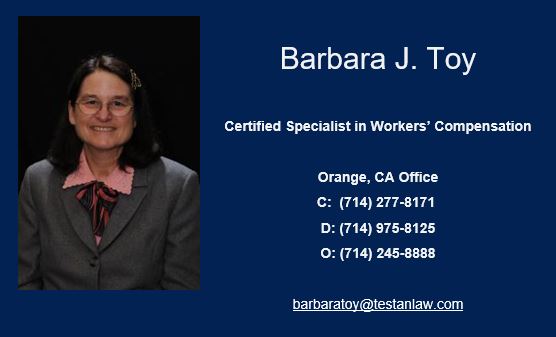Workers' Compensation and Civil Litigation Consultation & Defense











News
Court of Appeal Affirms and Explains Fitzpatrick Decision on Determinations of 100% Disability and Finds Injury from Sexual Misconduct of Treating Doctor to be Consequential Injury, by Barbara Toy
2021-06-09
Applied Materials v. WCAB & XL Specialty v. WCAB: Court of Appeal Affirms and Explains Fitzpatrick Decision on Determinations of 100% Disability and Finds Injury from Sexual Misconduct of Treating Doctor to be Consequential Injury.
On June 1, 2021, the 6th District Court of Appeal certified its decision in the two cases, Applied Materials v. WCAB and XL Specialty v. WCAB (jointly referred to as “Applied Materials”), for publication, making it citable authority. It is a long decision (74 pages) that covers a lot of issues, but the two that have the greatest significance are determination of total disability and that injury from sexual misconduct of a treating doctor can be found to consequential injury and therefore industrial.
Findings of 100% disability:
There are two ways to find total disability under Labor Code §4662, through one of the presumptions listed in 4662(a) or “in accordance with the fact” under 4662(b). In the past, a number of judges have found 100% disability based on a simple finding by the evaluating physician that the applicant was totally disabled, basing it on 4662(b), generally after providing findings that would rate out at less than 100%.
That changed in 2018 when the 3rd District found in Dept. of Corrections & Rehabilitation v. WCAB (Fitzpatrick)[1] that determinations of total disability under Labor Code §4662(b) had to be made pursuant to the rating process mandated by Labor Code §4660 as modified in the 2004 reforms. This meant that, if the usual rating came out at less than 100%, one of the elements of the rating string had to be rebutted by substantial evidence for the applicant to be found 100% disabled. If the basis for finding the applicant 100% disabled was inability to compete in the open labor market, that had to be determined through a vocational expert to rebut the FEC element of the rating.
The 6th District is now the second Court of Appeal to address this issue, in the Applied Materials case, in which our office represented one of the two Petitioners. It determined that Fitzpatrick was properly decided and that the approach taken by the Fitzpatrick court in reconciling these two sections was correct. It clarified the required process for finding 100% disability under Section 4662(b), indicating a process similar to what is required in the Almaraz/Guzman[2] line of cases, that findings first have to be provided based on the standard application of the AMA Guides, then, to get to a higher level of disability, one of the elements of the rating under Section 4660 would have to be specifically rebutted by substantial evidence. In a vocational case, it is not enough that a doctor state that the applicant is unable to work, as that is outside a doctor’s expertise; evidence from a vocational expert would be needed in a 100% case just as with any lessor level of disability to successfully rebut the FEC element of the rating under Ogilvie v. WCAB[3] and related cases.
We expect that this decision will help limit findings of 100% disability to cases where the applicant is genuinely at that level and keep the findings lower for those where a doctor makes a finding of 100% disability that is not based on substantial evidence.
Injury from Sexual Misconduct of Treating Doctor as Consequential Injury:
In Applied Materials, the applicant claimed psychiatric injury from a sexual relationship with her treating doctor; this relationship occurred more than five years after she last worked for the employer. Although the sexual activity was all at the applicant’s home, the doctor was there with the applicant’s consent, and the sexual activity was consensual, the Court found that she could not give legal consent because, under Business and Professions Code §729(b) consent was not a defense. That code section makes a physician’s “sexual exploitation” of a patient a criminal act, and the doctor’s actions fit the definition of “sexual exploitation” in that section.
Factors the Court referenced as showing ties to the employment though treatment for the industrial injury were that the applicant had treated with the doctor for her industrial injuries for about six years at the time this misconduct occurred, he was within the employer’s MPN, treatment was authorized and paid for by the employer, the applicant had a history of overmedication and at the time of the misconduct the doctor was prescribing multiple medications for her, and sexual contact took place during treatment sessions (though not intercourse; the claimed PTSD was from the last time they had intercourse).
This was a case of first impression, so having a doctor in a Workers’ Compensation case engage in sexual exploitation of a patient resulting in injury to that patient is fortunately pretty rare. Overall, the Court seems to require a factual analysis of the factors linking the sexual misconduct to the employment through the treatment relationship, but their standard for proximate cause under Labor Code §3600 was whether the employment was “one of the contributing causes without which the injury would not have occurred,” a much lower standard than tort proximate cause. Even though they found the treatment provided enough connection between the sexual misconduct and the employment that the injury resulting from it was compensable as a resultant injury, they did not find that this was a new injury caused by the industrial treatment, so apportionment still applies.
The significance of this finding is that injury to an applicant from misconduct by a doctor that is not part of the treatment the doctor is providing and therefore not medical malpractice can be found a compensable consequence of the industrial injury, but apportionment would still apply as it would not be an injury caused by the treatment itself.
